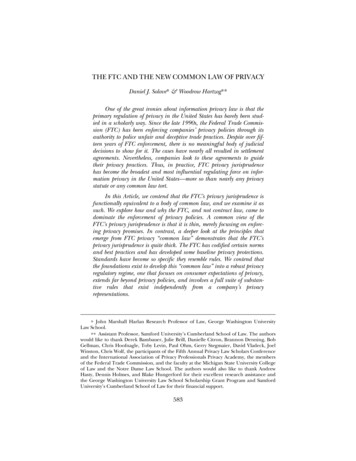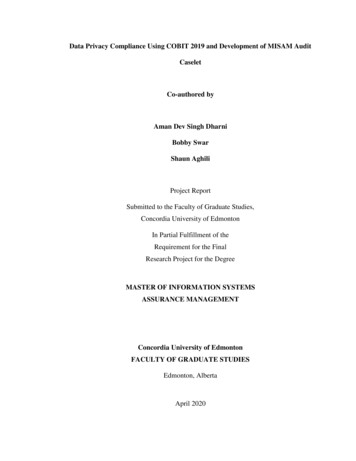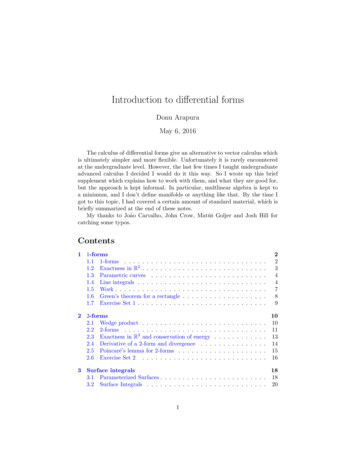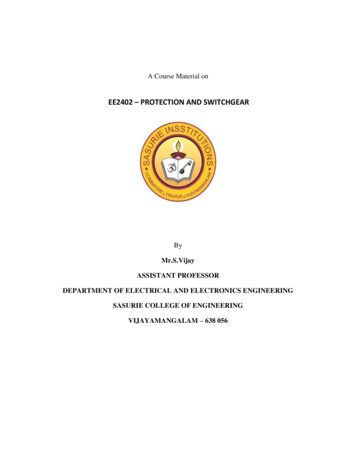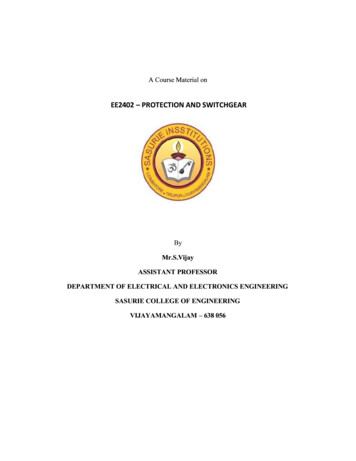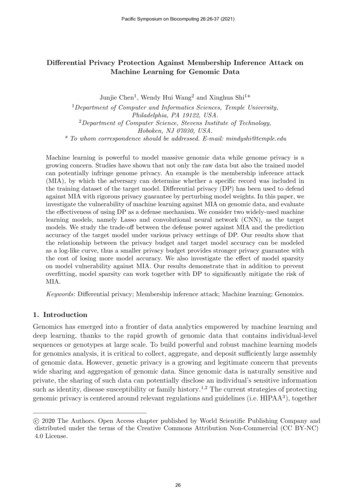
Transcription
Pacific Symposium on Biocomputing 26:26-37 (2021)Differential Privacy Protection Against Membership Inference Attack onMachine Learning for Genomic DataJunjie Chen1 , Wendy Hui Wang2 and Xinghua Shi1 *1 Departmentof Computer and Informatics Sciences, Temple University,Philadelphia, PA 19122, USA.2 Department of Computer Science, Stevens Institute of Technology,Hoboken, NJ 07030, USA.* To whom correspondence should be addressed. E-mail: mindyshi@temple.eduMachine learning is powerful to model massive genomic data while genome privacy is agrowing concern. Studies have shown that not only the raw data but also the trained modelcan potentially infringe genome privacy. An example is the membership inference attack(MIA), by which the adversary can determine whether a specific record was included inthe training dataset of the target model. Differential privacy (DP) has been used to defendagainst MIA with rigorous privacy guarantee by perturbing model weights. In this paper, weinvestigate the vulnerability of machine learning against MIA on genomic data, and evaluatethe effectiveness of using DP as a defense mechanism. We consider two widely-used machinelearning models, namely Lasso and convolutional neural network (CNN), as the targetmodels. We study the trade-off between the defense power against MIA and the predictionaccuracy of the target model under various privacy settings of DP. Our results show thatthe relationship between the privacy budget and target model accuracy can be modeledas a log-like curve, thus a smaller privacy budget provides stronger privacy guarantee withthe cost of losing more model accuracy. We also investigate the effect of model sparsityon model vulnerability against MIA. Our results demonstrate that in addition to preventoverfitting, model sparsity can work together with DP to significantly mitigate the risk ofMIA.Keywords: Differential privacy; Membership inference attack; Machine learning; Genomics.1. IntroductionGenomics has emerged into a frontier of data analytics empowered by machine learning anddeep learning, thanks to the rapid growth of genomic data that contains individual-levelsequences or genotypes at large scale. To build powerful and robust machine learning modelsfor genomics analysis, it is critical to collect, aggregate, and deposit sufficiently large assemblyof genomic data. However, genetic privacy is a growing and legitimate concern that preventswide sharing and aggregation of genomic data. Since genomic data is naturally sensitive andprivate, the sharing of such data can potentially disclose an individual’s sensitive informationsuch as identity, disease susceptibility or family history.1,2 The current strategies of protectinggenomic privacy is centered around relevant regulations and guidelines (i.e. HIPAA3 ), togetherc 2020 The Authors. Open Access chapter published by World Scientific Publishing Company anddistributed under the terms of the Creative Commons Attribution Non-Commercial (CC BY-NC)4.0 License.26
Pacific Symposium on Biocomputing 26:26-37 (2021)with the controlled access of individual-level genomic data (e.g. dbGaP4 ). However, we arein great need of new techniques for protecting genetic privacy toward an overarching goal ofachieving trustworthy biomedical data sharing and analysis. Specifically, it is imperative todevelop computational strategies to mitigate leakage of genetic privacy including the followingtwo types of privacy leakage: Privacy leakage via sharing data: an individual’s genomic data record may be leaked bysharing raw genomic data or summary statistics data; and Privacy leakage via sharing models: the information that an individual’s genomic data isincluded in the training dataset of a particular machine learning model, may be leaked bysharing the model.5While most of the prior works focus on the former type of privacy leakage resulted fromsharing data,6–8 in this study, we mainly focus on the latter type of privacy leakage fromsharing machine learning models. Several studies have recently showed that trained modelsmight memorize training data and thus disclose privacy of data records.9,10 Although thereexists a wide spectrum of attacks on machine learning models, the membership inference attack(MIA)11 has recently attracted research efforts that induces privacy leakage when sharingmachine learning models. More specifically, MIA refers to an attack to infer if the targetrecord was included in the target model’s training dataset. MIA has been demonstrated asan effective attack on images and relational data.5,11,12 However, it remains unclear if MIA iseffective on genomic data that significantly differ from conventional data.Although less explored in genomics study, membership privacy leakage does pose an emerging risk given the increasing application and sharing of machine learning models in genomicdata analysis. One particular scenario is that a publicly accessible model trained on valuablepatient data may leak the privacy of patient.13 For example, suppose a cancer treatment center builds a machine model to predict therapeutic responses based on patients’ genomic andother biomedical data. The cancer center then releases the trained model to the public (e.g. forpublications or depositing the model into a public model repository) or deploys the model asa machine-learning-as-a-service platform (e.g. Amazon Web service, Microsoft Azure, GoogleCloud). An adversary may use the model’s output to infer if a person, whose genomic datathe adversary has access to, is a cancer patient or cancer survivor, and such information mayprovide the adversary some additional information that can be exploited. Hence, in this study,we will investigate the efficiency of MIA on machine learning models for phenotype predictionbased on genomic data, a widely assessed prediction task carried out in agriculture, animalbreeding, and biomedical science.To defend against various attacks including MIA, a few techniques have been developed tomitigate privacy leakage such as homomorphic encryption,14 federated learning,15 and differential privacy (DP).16 While homomorphic encryption and federated learning are mainly usedto provide privacy protection for data sharing,17,18 DP provides a popular solution for publiclysharing information not only about the data19 but also the models.20 The idea behind DP isthat the query results cannot be used to infer information about any single individual, if theeffect of perturbing in the database is small enough.16 Recently, multiple defense mechanismsagainst MIA21–23 have been explored, with DP16 standing out as an efficient strategy that27
Pacific Symposium on Biocomputing 26:26-37 (2021)provides a rigorous privacy guarantee against MIA.11 Previous studies on imaging data24,25have shown that DP is an effective solution for granting wider access to machine learningmodels and results, while keeping them private. Therefore, we will mainly consider DP as adefense mechanism against MIA, given its theoretical privacy guarantee and its applicabilityfor data and models. In this study, we investigate the effectiveness of using DP as a defensemechanism against MIA for phenotype prediction on genomic data to prevent the risk of sharing two widely-used machine learning methods including Lasso26 ) and convolutional neuralnetwork (CNN27 ). The main contributions of our study lie in two folds:First, we investigate the vulnerability of machine learning against MIA on genomic data,and evaluate the effectiveness of using DP as a defense mechanism. Particularly, we evaluatethe trade-off between the defense power against MIA and the prediction accuracy of the targetmodel under various privacy settings of DP. Our results show that the relationship betweenthe privacy budget and target model accuracy can be modeled as a log-like curve, and hencethere exists a trade-off between privacy and accuracy near the turning point.Second, we evaluate the effect of model sparsity on privacy vulnerability to effectivelydefend against MIA. Genomic data is primarily high dimensional, where the feature size issignificantly larger than sample size. Hence, adding sparsity (e.g. the regularization terms inLasso models) to machine learning models is a critical and effective strategy to alleviate thecurse of dimensionality and avoid overfitting high-dimensional genomic data. Our results showthat model sparsity together with DP can significantly mitigate the risk of MIA, in additionto providing robust and effective models for genomic data analysis.2. Related WorkMembership inference attack (MIA). MIA is a privacy-leakage attack that predictswhether a given record was used in training a target model based on the output of the targetmodel for the given record.11 Shokri et al.11 is the first work that defines MIA and inspires afew follow-up studies. For example, Truex et al.28 characterize the attack vulnerability withrespect to the types of learning models, data distribution, and transferability. Salem et al.5design new variants of MIA by relaxing the assumptions of model types and data. Long et al.12generalize MIA by identifying vulnerable records and indirect inference. While most existingworks focus on MIA against discriminative models, relatively fewer works have consideredMIA against generative models.29,30 Liu et al.,31 Song et al.32 and Hayes et al.33 propose newMIA variants against deep learning models including variational autoencoders (VAEs) andgenerative adversarial networks (GANs). These MIA attacks require only black-box accessto a trained model. In practice, many studies usually release their models with white-boxaccess.17 Such white-box access provides many additional properties of the training models,which make an MIA attack even easier.Differential privacy (DP). DP16 has become the most widely-used approach that measuresthe disclosure of privacy pertaining to individuals. The guarantee of a DP algorithm lies in thatanything the algorithm might output on a database containing some individual’s information,is almost as likely to have come from a database without that individual’s information. DPstrategies have been applied to preserve genome privacy in genome-wide association studies28
Pacific Symposium on Biocomputing 26:26-37 (2021)(GWAS).8 For example, Johnson et. al 34 developed privacy-preserving algorithms for computing the number and location of single nucleotide polymorphisms (SNPs) that are significantlyassociated with certain diseases. Uhlerop et. al 7 proposed a method that allows for the releaseof aggregate GWAS data without compromising an individual’s privacy. Various DP mechanisms also have been developed35 to preserve model privacy, including a logistic regressionwith DP36 and a random forest algorithm with DP.37 Going beyond classic machine learningmodels, Shokri et al.38 adapted DP to deep neural networks. Abadi et al.25 developed a differentially private stochastic gradient descent (SGD) algorithm for the TensorFlow framework.3. MethodsIn this section, we introduce the methods used in our study, including differential privacy andmembership inference attack. The supplementary materials and source code are available athttps://github.com/shilab/DP-MIA.git.3.1. Membership inference attack (MIA).As illustrated in Fig. 1, MIA assumes that a target machine learning model is trained ona set of labeled samples from a certain population. The adversary utilizes the output of thetarget model of a given sample to infer the membership of the sample (i.e., the given samplewas included in the training dataset of the target model). Formally, let ftarget () be the targettrain which contains labeled samples (x, y). The output ofmodel trained on a private dataset Dtargetthe target model is a probability vector y ftarget (x) whose size is the number of classes. Lettrain , that is generated by the attackerfshadow () be the shadow model trained on a dataset Dshadowto mimic the target model ftarget () (i.e. take similar input and output of the target model).We use the same assumption as in the pioneering work,11 that the shadow dataset is disjointtrain D train ). Letfrom the private target dataset used to train the target model (i.e., Dshadowtargetfattack () be the attack model. Its input xattack is composed of a predicted probability vector anda true label, where the distribution of predicted probability vectors heavily depends on thetrue label. Since the goal of the attack is membership inference, the attack model is a binaryclassifier, in which the output 1 indicates that the target record is in the training dataset, and0 otherwise.To construct the MIA model, a shadow training technique is often applied to generate theground truth of membership inference. One or multiple shadow models are built to imitatethe target model. In this study, we consider the white-box setting, where the adversary hasthe full knowledge of the target model including its hyperparameters and network structure.This white-box threat setting reflects the observations that researchers often share their fullmodels and accidentally white-box representations of models may fall into the hands of anadversary via means such as a security breach.3.2. Differential privacy (DP)DP describes the statistics of groups while withholding individuals’ information within thedataset.16 Informally, DP ensures that the outcome of any data analysis on two databases29
Pacific Symposium on Biocomputing 26:26-37 (2021)Prediction vectorwith probabilities Prediction TrueProbabilities LabelShadow datasetMimic target modelTarget modelPrediction vectorwith probabilitiesPrediction True In/OutProbabilities Label datasetIn trainingdatasetMembership inferenceTarget datasetUnused datasetAttack modelShadow modelXYAttack datasetFig. 1. An illustration of the membership inference attack. A record in the target datasetis fed into the target model and outputs a predicted probability vector. The shadow dataset andunused dataset are either simulated or selected from publicly available datasets that have the samedistribution as the target dataset. A shadow model is built on the shadow and unused datasets tomimic the target model. The attack dataset is composed of the probability vectors and true labels.The attack model performs a binary classification (in/out) to determine whether a data record isincluded in the training dataset (in) or not (out).differing in a single record does not vary much. Formally, a randomized algorithm M : D Rwith domain D and range R is (ε, δ)-differentially private if for all subsets of S R and for alldatabase inputs d, d0 D such that kd d0 k1 1 satisfied with Pr[M(d) S] eε Pr[M(d0 ) S] δ . Here, kd d0 k1 requires that the number of records that differ between d and d0 is atmost 1. The parameter ε is called the privacy budget and a lower ε indicates stronger privacyprotection. The parameter δ controls the probability that ε-differential privacy is violated.A lower δ value signifies greater confidence of differential privacy. If δ 0, we say M is εdifferentially private, and simplify (ε, 0)-differential privacy as ε-differential privacy. A rule ofthumb for setting δ is that it is smaller than the inverse of the training data size (i.e. 1/kdk).254. Experimental Setup4.1. DatasetWe evaluate the effectiveness of DP against MIA on a widely-used yeast genomic dataset.39We choose this yeast dataset because it provides an ideal scenario for evaluating the powerand privacy of phenotype prediction with well-controlled genetic background and phenotypequantifications, without worries about complex genetic background and the hard-to-definedphenotypes in humans. We extract and filter missing values of the original genotypes39 andorganize them into a matrix that contains genotypes of 28,820 genetic variants or features (withvalues of 1 and 2 representing the allele comes from a laboratory strain or a vineyard strainrespectively) from 4,390 individuals. Similar to any typical human genomic data, the yeastdata is high dimensional where the feature size (28,820) is much larger than the sample size(4,390). We also obtain phenotypes or labels of these 4,390 individuals for 20 traits,39 where30
Pacific Symposium on Biocomputing 26:26-37 (2021)we pick the trait of copper sulfate as our target phenotype in this study. This trait representsthe growth of yeast by measuring the normalized colony radius at a 48-hour endpoint inagar plates with different concentrations of copper sulfate.39 Since MIA is mainly launchedon classification models, we binarize the quantitative phenotype values as 1 if they are largerthan the mean value and 0 otherwise.4.2. Implementation of target modelsFor the target models of MIA, we implement a Lasso model26,40 as an example of sparselearning models, and a CNN model27,41,42 as an example of deep learning model, that arewidely-used in analyzing high-dimensional genomics data.Lasso is a regression analysis method that performs variable selection with a regularizationterm using 1 norm.26 Lasso minimizes the residual sum of squares subject to the sum of theabsolute value of the coefficients being less than a constant. The general objective of Lasso1is min ky Xβk22 λkβk1 , where X is the feature matrix, β is the coefficient vector, and y isβ2the label vector. λ is the coefficient of 1 norm which controls the model sparsity. Lasso usesan 1 norm regularization to shrink the parameters of the majority of features to zero whichare trivial, and those variants corresponding to non-zero terms are selected as the identifiedimportant features. We set λ to be 0 (without model sparsity) and 0.001352 (with modelsparsity selected using the glmnet package in R43 ).CNN has shown its capability to capture local patterns in genomic data.27 For demonstration, the CNN model in this study includes one CNN layer, followed by a dense layer as anoutput layer. To improve model robustness, the 1 norm is applied to all layers to shrink smallweights to zero. We utilize a grid search with 5-fold cross validation to find the optimizedhyperparameters. In particular, we use two different learning rates (0.01 and 0.001) and twomicro batch sizes (50% and 100% of batch size). Regarding 2 norm clipping which determines the maximum amounts of 2 norm clipped to cumulative gradient across all networkparameters from each microbatch, we use four unique 2 norm clipping values (0.6, 1.0, 1.4,and 1.8 respectively). For CNN models, we use two different kernel sizes (5 and 9), and twodifferent numbers of kernels (8 and 16). Furthermore, we set the values of λ as 0 (withoutmodel sparsity) and 0.001352 (with model sparsity chosen using glmnet43 ).4.3. Implementation of DPWe implement DP on both Lasso and CNN models with and without 1 norm respectively,using a Python library called TensorFlow-privacy.44 DP is implemented in these models byadding a standard Gaussian noise on each gradient of the SGD optimizer. The major processfor training a model with parameters θ by minimizing the empirical loss function L(θ) withdifferentially private SGD, is summarized as the following: at each step of computing theSGD: 1) compute the gradient θ L(θ, xi ) for a random subset of examples; 2) clip the 2 normof each gradient; 3) compute the average of gradients; 4) add some noise in order to protectprivacy; 5) take a step in the opposite direction of this average noisy gradient; 6) in additionto outputting the model, compute the privacy loss of the mechanism based on the informationmaintained by the privacy accountant.31
Pacific Symposium on Biocomputing 26:26-37 (2021)In the DP implementation, the privacy budget is determined by a function that takesmultiple hyperparameters as the input. These hyperparameters include the number of epochs,batch size and noise multiplier. The noise multiplier controls the amount of noises added ineach training batch. In general, adding more noise leads to better privacy and lower utility.The hyperparameters used in this study are: two epoch sizes (50 and 100), two batch sizes (8and 16) and five noise multipliers (0.4, 0.6, 0.8, 1.0, 1.2). We set the value of the parameter δas the inverse of training dataset size (i.e. δ 0.00066489).254.4. Implementation of MIATo train differentially private machine learning models and perform MIA, we split the wholedataset into two disjoint subsets, one as the private target dataset and the other one as thepublic shadow dataset.11 We randomly split the public shadow dataset, with 80% used formodel training and 20% used to generate the ground truth of the attack model. We focus on awhite-box model attack, where the target model’s architecture and weights are accessible, toevalute how much privacy will be leaked in the worst case. Hence, the shadow model has thesame architecture and hyperparameters as the target model. We use an open-source library ofMIA45 to conduct MIA attacks on the Lasso and CNN models. We build one shadow modelon the shadow dataset to mimic the target model, and generate the ground truth to trainthe attack model. The attack dataset is constructed by concatenating the probability vectoroutput from the shadow model and true labels. If a sample is used to train the shadow model,the corresponding concatenated input for the attack dataset is labeled ‘in’, and ‘out’ otherwise.For the attack model, we build a random forest with 10 estimators and a max depth of 2.Each MIA attack is randomly repeated 5 times.4.5. Evaluation metricsOur evaluation metrics include: (1) the mean accuracy of 5-fold cross validation of the targetmodel on the private target dataset, and (2) the mean of MIA accuracy of 5 MIA attacks. Theaccuracy of the target model on the training (testing, resp.) data is measured as the precision(i.e., the fraction of classification results that are correct) of the prediction results on thetraining (testing, resp.) data. We follow the pioneering work11 and use the attack accuracy tomeasure MIA performance. All samples in the target dataset are fed into the attack model.5. Results5.1. Vulnerability of target model against MIA without DP protectionWe investigate the vulnerability of Lasso and CNN models against MIA for predicting thetarget phenotype without any DP protection. Table 1 shows the accuracy of the two targetmodels without DP and attack accuracy of MIA on these models. When the models are notsparse (λ 0), Lasso and CNN achieves a similar accuracy on the target dataset (0.7910vs. 0.7894). The attack accuracy of MIA on Lasso and CNN with no sparsity is 0.5728 and0.5726 respectively, which is better than random guess (0.5) and on a par with MIA accuracyreported in other areas.11 The high dimensionality of genomic data makes MIA on genomic32
Pacific Symposium on Biocomputing 26:26-37 (2021)data much harder than other types of datasets, since shadow models hardly mimic the targetmodel on a high dimensional dataset. Nonetheless, with such a MIA accuracy, the adversarystill has a chance to infer the membership in a genomic dataset. After introducing modelsparsity by adding an 1 norm (λ 0.001352) to coefficients (in Lasso) or weights (in CNN),the target accuracy of both models is slightly improved and their attack accuracy is reduced.Table 1. Model performance against MIA (without DP).MethodsLasso (λ 0)Lasso (λ 0.001352)CNN (λ 0)CNN (λ 0.001352)Target 1570.01990.0225Attack 0420.00590.00505.2. Impact of privacy budget on the target model accuracyIn order to evaluate the impact of DP on the accuracy of the target model, we conduct a gridsearch to find different privacy budgets and quantitatively investigate the impact of privacybudget. As summarized in Fig. 2(a), we observe that the fitting curve between the privacybudget and the target accuracy can be represented as a log-like curve. The performance of alltarget models rapidly deteriorates as the privacy budget becomes smaller. When the privacybudget is large, both non-sparse Lasso (λ 0) and non-sparse CNN (λ 0) models achievesimilar target accuracy. Compared with non-sparse models, the target accuracy of sparse Lasso(λ 0.001352) and sparse CNN (λ 0.001352) models, is downgraded by DP to a more extenteven when the privacy budget is large. This is because sparse models only keep coefficients orweights which are higher than λ, and shrink those coefficients or weights that are smaller thanλ to 0. Therefore, adding a noise to those large weights will have a more significant impact onthe accuracy of the target model.5.3. Effectiveness of DP against MIATo assess the effectiveness of DP against MIA, we conduct MIA on the target models withdifferent DP budgets. Our results (Fig. 2(b)) show that, for Lasso models, the fitting curvebetween the privacy budget and the target accuracy can be represented as a log-like curve.For CNN, we notice that the curve of attack accuracy is different from that of Lasso, since theattack accuracy becomes unstable when the epsilon is smaller than 10. However, CNN withDP still can provide strong privacy protection. In both Lasso and CNN models, we observethat DP can defend against MIA effectively by perturbing the prediction vector output fromthe target model, so that the adversary cannot easily infer the membership from such noisypredictions.According to results in Fig. 2, we choose the turning point with a maximum curvaturein the log curve as a trade-off between privacy budget and model accuracy. As the privacy33
Pacific Symposium on Biocomputing 26:26-37 (2021)budget becomes tight, the target accuracy is rapidly dropped after this turning point, whilethe target model with DP can still provide sufficient protection against MIA. Based on thisobservation, we choose the privacy budget of 10 that best addresses the trade-off betweenprivacy and target accuracy in this study.(b)(a)Fig. 2. Accuracy values of the (a) target model and (b) attack model respectively undervarious privacy budgets (5-fold cross validation). Curves indicate the fitted regression lines;shadow areas represent the 95% confidence intervals for corresponding regressions. Horizontal dottedlines represent model performances without DP.5.4. Effect of model sparsityWe investigate the effect of model sparsity by adding an 1 norm to model coefficients orweights. Due to the large hyperparameter searching space, we only use the value of λ 0.001352for both Lasso and CNN, chosen using the glmnet package.43 Our results (Table 1) showthat adding sparsity to a model can improve the accuracy of the target model and reduce theattack accuracy of MIA when DP is not deployed. This is because that on the high-dimensionaldataset, a Lasso or CNN model with no sparsity (i.e. λ 0) can overfit the training data.However, by introducing model sparsity, the overfitting of the model is reduced, leading tobetter accuracy of the target model.We further explore the impact of model sparsity on the accuracy of the target model whenDP is deployed. We observe that sparse models with DP have slightly worse model accuracycompared with those non-spare models with DP (Fig. 2(a)). This is because each weight ina sparse model is important to prediction results; and any perturbation to these weights cansignificantly impact model accuracy. We also find that when the privacy budget is smallerthan the trade-off (e.g. ε 10 in our results), the accuracy of the target model is relativelyinsensitive to model sparsity compared with larger privacy budgets (i.e., ε 10). Next, weevaluate the impact of model sparsity on the defense power of DP against MIA. As shownin Fig. 2(b), sparse models provide better privacy protection compared with those modelswithout sparsity, given the same DP budget ε.34
Pacific Symposium on Biocomputing 26:26-37 (2021)6. ConclusionWe investigate the vulnerability of trained machine learning models for phenotype predictionon genomic data against a new type of privacy attack named membership inference attack(MIA), and evaluate the effectiveness of using differential privacy (DP) as a defense mechanismagainst MIA. We find the MIA can successfully infer if a particular individual is included in thetraining dataset for both Lasso and CNN models, and DP can defend against MIA on genomicdata effectively with a cost of reducing accuracy of the target model. We also evaluate thetrade-off between privacy protection against MIA and the prediction accuracy of the targetmodel. Moreover, we observe that introducing sparsity into the target model can further defendagainst MIA in addition to implementing the DP strategy.Using yeast genomic data as a demonstration, our study provides a novel computationalframework that allows for investigating not only the privacy leakage induced from MIA attacks on machine learning models, but also the efficiency of classical defending mechanismslike DP against these new attacks. Nonetheless, there are several limitations of our currentstudy. We are limited to white-box setting where hyperparameters and model architectures areaccessible to an adversary in this study. In the future, we will also evaluate black-box accesswhere the adversary simply uses the target model as a black-box for query without any insideinformation of the model. We will comprehensively explore the relationship between privacybudget and model accuracy, under various combinations of model hyperparameters space andphenotypes. We will apply the framework to analyze large-scale human genomic data whereprivacy is of a realistic concern. We will investigate whether DP gives unequal privacy benefits to genomes from minority groups compared with those from majority groups. We willinvestigate other factors (e.g., the number of classes) and conventional genomic analysis (e.g.associations studies, risk prediction) to assess the attack power of MIA and the effectivenessof appropriate defense mechani
Lasso models) to machine learning models is a critical and e ective strategy to alleviate the . (SGD) algorithm for the TensorFlow framework. 3. Methods In this section, we introduce the methods used in our study, including di erential privacy and membership inference attack. The supplementary materials and source code are available at

